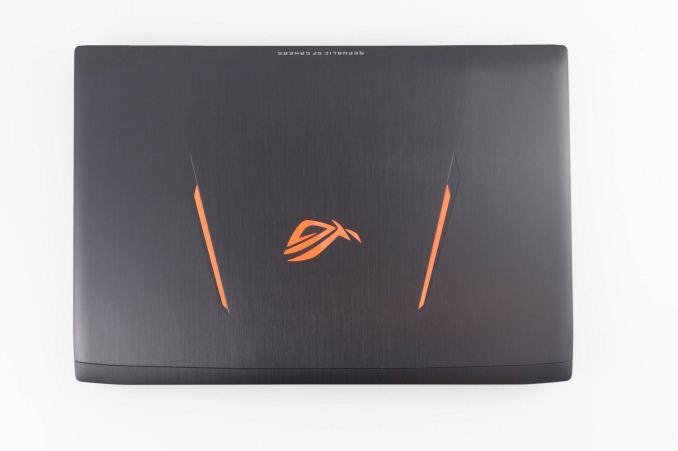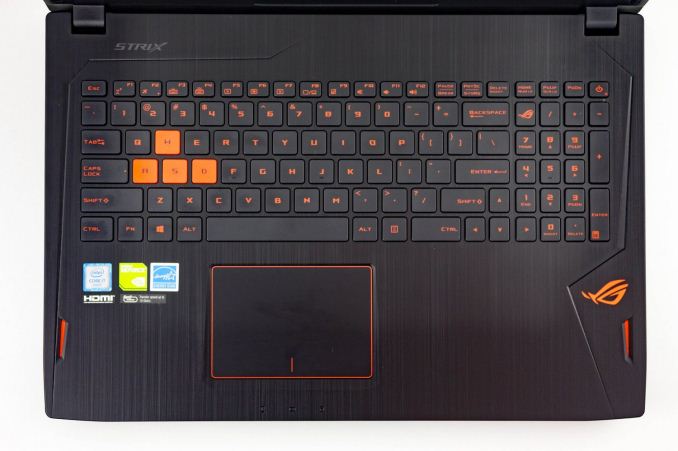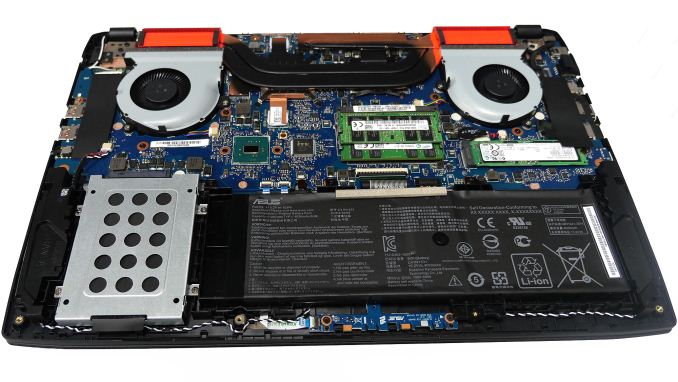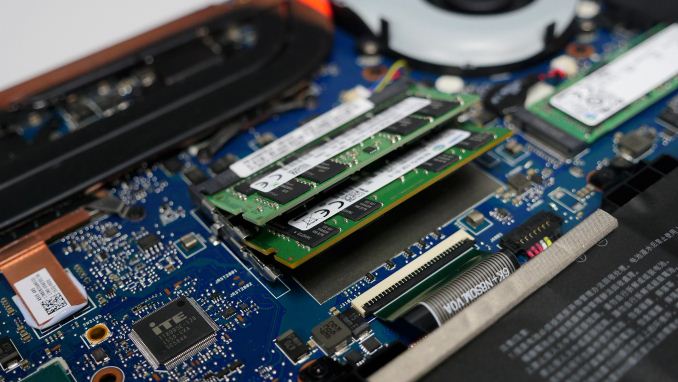The ASUS ROG Strix GL502VS Review: Mainstream GTX 1070 with G-SYNC
by Brett Howse on December 9, 2016 8:00 AM ESTDesign
Without putting too fine a point on it, ASUS can design some stunning notebooks, but this is not one of them. Stepping down to their value line keeps the same powerful internals, but to hit this price point ASUS has taken some liberties with the chassis design. The entire notebook is built from a fairly low quality plastic, with the exception of the lid which has a metal top. The top has a brushed finish with lines running parallel down the entire device, which looks nice, but that’s where the premium materials end.
Opening the notebook, the same brushed finish is replicated on the plastic keyboard deck, but this time on the plastic finish. The keyboard itself features 1.6 mm of travel with red backlighting, but the keyboard feel lacks the nice feel of some of the other ASUS notebooks. The WASD keys are red with black fonts, compared to the rest of the keys which are black with red fonts, and although the look won’t appeal to everyone, it does help quickly identify the most needed keys for gaming. ASUS continues its silly tradition of having the power key right in the keyboard, with it at the top right. If you accidently go to press the minus key, you may end up shutting off the laptop. There’s no good reason for them to put it there, although at least on this notebook, with its extra number pad, it is less likely to get hit than on one of their smaller notebooks where it is right beside the delete key. This seems like a small gripe, but shutting off your computer when going to hit a key is not a great experience.
The trackpad on this notebook does feature the Microsoft Precision Touchpad drivers, for better or for worse, and it’s nice to see Microsoft reigning this in. They still have some work to do with the drivers, but at least it is a consistent experience across devices now. That being said, the trackpad on this notebook is not quite as smooth as some other notebooks, and picks up fingerprints quite readily. It would be nice to see a glass trackpad, although once again the budget comes into play. Luckily a good mouse is going to be required for gaming regardless, so this isn’t as big of an issue as it is on a more portable device.
Being a large gaming laptop, there is expandability with the GL502VS, and just a couple of screws will let you pop off the bottom and access the memory, which has two SODIMM slots, the M.2 SSD, and the SATA drive. Maximum memory is 32 GB through two 16 GB DDR4 modules. On our 16GB sample, only one memory slot was occupied for single channel memory performance.
Interior photos courtesy of rog.asus.com
Overall the design of the ASUS GL502VS is kind of disappointing. The top of the notebook is a very nice looking metal, but the remainder of the notebook is a fairly low grade plastic. ASUS does build some nice notebooks, but to hit their budget on this one with the components on the inside, clearly some cost cutting was necessary. They have also gone a bit overboard with the red accents on this notebook, and especially with the bright shade of red chosen, although the almost orange WASD keys do look nice and red with the keyboard backlighting on.

















54 Comments
View All Comments
negusp - Friday, December 9, 2016 - link
In most cases I would agree with you, but not in this case. This laptop is going to be rarely moved. It's effectively a 15-inch DTR.The thing is, a complete desktop system would still be about ~25% cheaper. Even more, dedicated input peripherals and screen make for a much better experience than gaming on a small laptop. Might as well purchase a cheap laptop and build a good rig.
Even more, I can build a $300 PC that can best a PS4, easy. And there are plenty of compatible controllers and MCE remotes that can be used for cheap as a multimedia system.
Samus - Sunday, December 11, 2016 - link
While I agree with your message, you most definitely cannot build a desktop PC for $300 that rivals a PS4 in virtually any media or gaming tasks. Even if you pirate the OS.xenol - Friday, December 9, 2016 - link
Also I didn't realize there was another indent level so I thought your reply was for my comment :PGreat_Scott - Friday, December 9, 2016 - link
At ~$1600 I'm struggling to imagine that anyone cares. Sure, it might even be a good deal, but I can't remember the last time *anyone I know of* spent 4 figures on a laptop. ~$999 at the most or irrelevant.faster - Friday, December 9, 2016 - link
It's gaming laptop. You can't play Battlefield1 on a $999 laptop. This is an intriguing product.p1esk - Sunday, December 11, 2016 - link
Why would anyone want to buy this laptop to play games? It's clearly too big and heavy to lug around if you want to game during your daily commute on a bus, and it's clearly not as fast as a (cheaper) desktop.DanNeely - Sunday, December 11, 2016 - link
Other than being slightly thicker to hold the bigger heat sinks in terms of size/weight this is comparable to a mainstream 15" laptop from 5-10 years ago. OTOH that 10yo mainstream laptop would probably weight 6 pounds instead of 5 like this one does.sundragon - Friday, December 23, 2016 - link
It's about 5.7 lbs when you actually weigh it. I'm not sure why ASUS says 4.8 lbs. The power adapter is large and weighs about 1.2 lbs so we're talking realistically 7lbs if you're moving it.mrcaffeinex - Friday, December 9, 2016 - link
It is not mainstream to me, but it does appear that more of what would have been deemed to be enthusiast in the past is now the upper mainstream.bigboxes - Friday, December 9, 2016 - link
Anything over $1k is not mainstream.